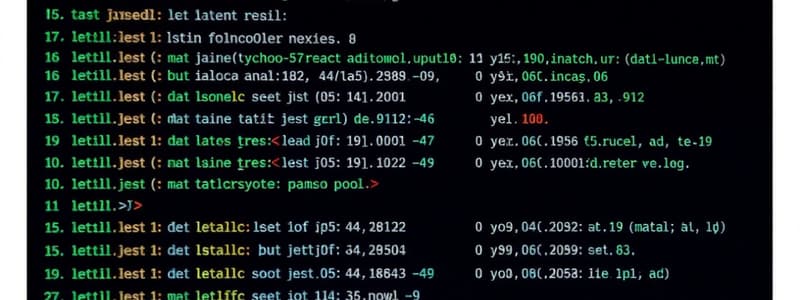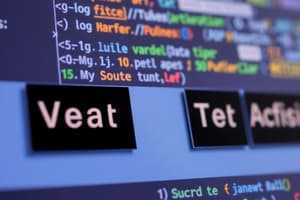Podcast
Questions and Answers
Which of the following values is an example of a Floating data type?
Which of the following values is an example of a Floating data type?
- Ali
- 15
- 3.14159 (correct)
- True
What is the correct way to represent a Boolean literal?
What is the correct way to represent a Boolean literal?
- False (correct)
- true
- 'False'
- "True"
Which of the following is NOT a valid identifier in Python?
Which of the following is NOT a valid identifier in Python?
- plus1
- variable_name
- _myVariable
- 1plus (correct)
Which statement is true regarding string literals?
Which statement is true regarding string literals?
How is the value 'Department of CSE-MUET' categorized?
How is the value 'Department of CSE-MUET' categorized?
What is the primary characteristic of a data literal?
What is the primary characteristic of a data literal?
Which example demonstrates a valid string literal?
Which example demonstrates a valid string literal?
Which combination accurately represents a Boolean expression?
Which combination accurately represents a Boolean expression?
What is a keyword in Python programming?
What is a keyword in Python programming?
Which of the following correctly describes a statement in Python?
Which of the following correctly describes a statement in Python?
Which of the following examples is NOT a valid variable name in Python?
Which of the following examples is NOT a valid variable name in Python?
What happens to a variable's type in Python when its value changes?
What happens to a variable's type in Python when its value changes?
What is the correct syntax for assigning values to variables in Python?
What is the correct syntax for assigning values to variables in Python?
Which of the following is an expression in Python?
Which of the following is an expression in Python?
Why are variable names case-sensitive in Python?
Why are variable names case-sensitive in Python?
Which of the following is TRUE regarding legal variable names in Python?
Which of the following is TRUE regarding legal variable names in Python?
What does the exponentiation assignment operator '**=' do?
What does the exponentiation assignment operator '**=' do?
Which of the following operators will return a Boolean value?
Which of the following operators will return a Boolean value?
Which function is used to convert a float number to an integer?
Which function is used to convert a float number to an integer?
If z starts at 5, what will be the value of z after executing z -= 2?
If z starts at 5, what will be the value of z after executing z -= 2?
What will the expression (p >= q) evaluate to if p = 10 and q = 20?
What will the expression (p >= q) evaluate to if p = 10 and q = 20?
What will happen if you apply the str() function to the number 33?
What will happen if you apply the str() function to the number 33?
If score is 80, which logical expression is True?
If score is 80, which logical expression is True?
What happens to a variable's value when a new assignment is made?
What happens to a variable's value when a new assignment is made?
Which operator produces the remainder of a division?
Which operator produces the remainder of a division?
If the variables p and q are assigned the values 2 and 3 respectively, what is the result of p ** q?
If the variables p and q are assigned the values 2 and 3 respectively, what is the result of p ** q?
Which of the following statements correctly assigns the value 1 to the variables a, b, and c?
Which of the following statements correctly assigns the value 1 to the variables a, b, and c?
What type of operator is responsible for assigning values to variables?
What type of operator is responsible for assigning values to variables?
What will be the output of the expression 9 // 2?
What will be the output of the expression 9 // 2?
Which of the following statements is true about Python variables?
Which of the following statements is true about Python variables?
What is the result of the expression 5 - 2 + 3 * 2?
What is the result of the expression 5 - 2 + 3 * 2?
Study Notes
Data Types
- Data can be classified into various types: numbers, strings, and booleans.
- Numbers:
- Integers (e.g. -547, 24, 5874)
- Floating-point numbers (e.g. -658.748, 45.214, 0.2547)
- Strings: Enclosed in single or double quotes (e.g. "computer", 'ICT110').
- Boolean: Represents logical values, either True or False.
Data Literals
- Literals: Fixed values for data types.
- Number literals: Written without quotes (e.g. 15, 25.14).
- String literals: Enclosed in quotes (e.g. 'Ali', "computer").
- Multiline strings: Using triple quotes (e.g. '''This is a multiline string''' or """This is a multiline string""").
- Boolean literals: Written without quotes (e.g. True, False).
Identifiers
- Identifiers are names for variables, functions, classes, or modules.
- Can include letters, digits, and underscores; cannot start with a digit.
- Examples: myCountry, other_1, plus1.
Keywords
- Reserved words with predefined meaning in Python; cannot be used as identifiers.
Statements and Expressions
- Statement: An instruction executable by the interpreter (e.g. z = 1).
- Expression: Combination of variables and operators that evaluates to a new value (e.g. z + 20).
Variables
- Variables are memory locations for temporary data storage.
- Each variable has a name (identifier), a data type, and a value.
- Python does not require explicit declaration of the variable's data type.
Legal Variable Names
- Variable names can include letters, underscores, and digits.
- Cannot start with a number or use Python keywords; are case-sensitive.
Assigning Values to Variables
- Variables created by assigning values (e.g. x = 5, name = "Python").
- The assigned value can change throughout program execution.
- Multiple variables can be assigned the same value simultaneously (e.g., a = b = c = 1).
Operators
- Operators perform mathematical or logical operations on data values.
- Types of operators in Python:
- Arithmetic Operators: (+, -, *, /, %, **, //)
- Assignment Operators: (=, +=, -=, *=, /=, **=, //=, %=)
- Comparison Operators: (==, !=, >, <, >=, <=)
- Logical Operators: and, or, not.
Arithmetic Operators
- Perform operations like addition, subtraction, multiplication, division.
- Support modulus and exponentiation operations.
Assignment Operators
- Assign computed values to variables (e.g. z += p is equivalent to z = z + p).
Comparison Operators
- Return Boolean values (True or False) based on comparisons between values.
Type Conversions
- Python allows explicit conversion between data types using:
int(): Convert to integer.float(): Convert to floating-point number.str(): Convert to string.
Type Function
- The
type()function is used to determine the data type of an object.
Studying That Suits You
Use AI to generate personalized quizzes and flashcards to suit your learning preferences.
Related Documents
Description
This quiz focuses on the fundamental concepts of programming, specifically on data types. You will explore different types of data, including integers, floating-point numbers, strings, and boolean values. Test your understanding of these essential elements in problem-solving and programming.





